• 'l'ake the ion-, bander off the M6 at spaghetti
Page 32
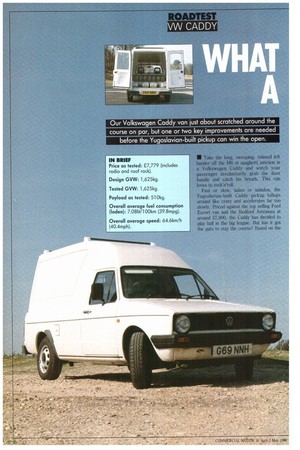
Page 33
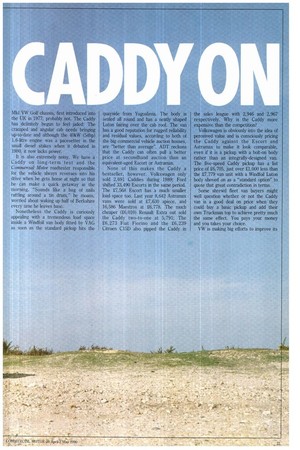
Page 34
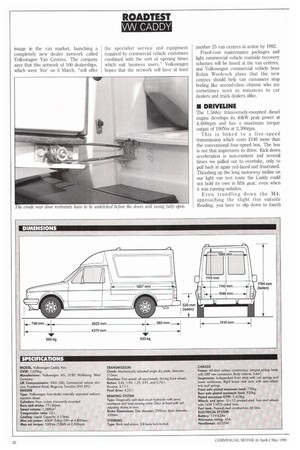
Page 35
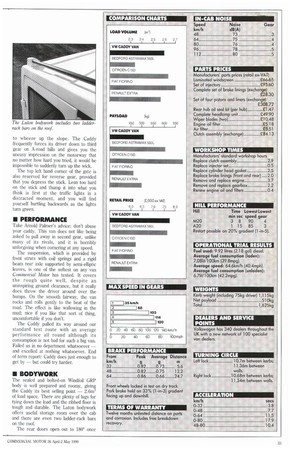
Page 36
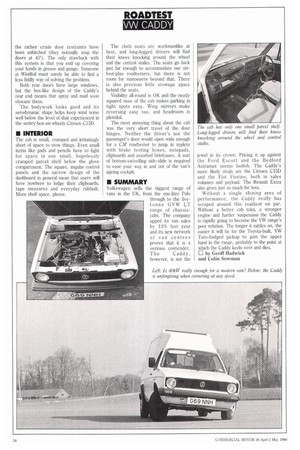
If you've noticed an error in this article please click here to report it so we can fix it.
junction in a Volkswagen Caddy and watch Your passenger involuntarily grab the door handle and catch his breath. Thi loves to rock'n'roll. Fast or slow, laden or unladen, Yugoslavian-built Caddy pickup lollops around like crazy and accelerates far too slowly. Priced against the top selling Ford Escort van and the Bedford Astramax at around £7,800, the Caddy has decided to play ball in the big league. But has it got the guts to stay the course? Based on the
MkI VW Golf chassis, first introduced into the UK in 1977, probably not. The Caddy has definitely begun to feel jaded: The cramped and angular cab needs bringing up-to-date and although the 40kiAT (54hp)
I.,' .. . 1.6-litre engine was a pacesetter in the , small diesel stakes when it debuted in : 1980, it now lacks power. It is also extremely noisy. We have a Caddy on long-term test and the Commercial Motor roadtester responsible for the vehicle always reverses into his drive when he gets home at night so that he can make a quick getaway in the morning. "Sounds like a bag of nails rattling around a tin drum," he moans, worried about waking up half of Berkshire every time he leaves base.
Nonetheless the Caddy is curiously appealing with a tremendous load space inside a Windfoil van body fitted by VAG as soon as the standard pickup hits the
quayside from Yugoslavia. The body is sealed all round and has a neatly shaped Luton fairing over the cab roof. The van has a good reputation for rugged reliability and residual values, according to both of the big commercial vehicle auction houses, are "better than average". ADT reckons that the Caddy can often pull a better price at secondhand auction than an equivalent-aged Escort or Astramax.
None of this makes the Caddy a bestseller, however. Volkswagen only sold 2,691 Caddies during 1989; Ford shifted 33,490 Escorts in the same period. The £7,568 Escort has a much smaller load space too. Last year 8,642 Astramax vans were sold at £7,630 apiece, and 16,586 Maestros at 26,778. The much cheaper (26,010) Renault Extra out sold the Caddy two-to-one at 5,791; The £6,273 Fiat Fiorino and the 26,239 Citroen C15D also pipped the Caddy in the sales league with 2,946 and 2,967 respectively. Why is the Caddy more expensive than the competition?
Volkswagen is obviously into the idea of perceived value and is consciously pricing the Caddy against the Escort and Astramax to make it look comparable. even if it is a pickup with a bolt-on body rather than an integrally-designed van. The five-speed Caddy pickup has a list price of £6,705, just over £1,000 less than the £7,779 van unit with a Windfoil Luton body shoved on as a "standard option" to quote that great contradiction in terms.
Some shrewd fleet van buyers might well question whether or not the Caddy van is a good deal on price when they could buy a basic pickup and add their own Truckrnan top to achieve pretty much the same effect. You pays your money and you takes your choice.
VW is making big efforts to improve its image in the van market, launching a completely new dealer network called Volkswagen Van Centres. The company says that this network of 100 dealerships, which went 'live' on 6 March, "will offer the specialist service and equipment required by commercial vehicle customers combined with the sort of opening times which suit business users." Volkswagen hopes that the network will have at least another 25 van centres in action by 1992.
Fixed-cost maintenance packages and light commercial vehicle roadside recovery schemes will be based at the van centres, and Volkswagen commercial vehicle boss Robin Woolcock plans that the new centres should help van customers stop feeling like second-class citizens who are sometimes seen as nuisances to car dealers and truck dealers alike.
• DRIVELINE
The 1,588cc transversely-mounted diesel engine develops its 40kW peak power at 4,800rpm and has a maximum torque output of 100Nm at 2,300rpm.
This is linked to a five-speed transmission which costs £146 more than the conventional four-speed box. The box is not that impressive to drive. Kick-down acceleration is non-existent and several times we pulled out to overtake, only to pull back in again red-faced and frustrated. Thrashing up the long motorway incline on our light van test route the Caddy could not hold its own in fifth gear, even when it was running unladen.
Even trundling down the M4, approaching the slight rise outside Reading, you have to slip down to fourth to wheeze up the slope. The Caddy frequently forces its driver down to third gear on A-road hills and gives you the uneasy impression on the motorway that no matter how hard you tried, it would be impossible to suddenly turn up the wick.
The top left hand corner of the gate is also reserved for reverse gear, provided that you depress the stick. Lean too hard on the stick and thump it into what you think is first at the traffic lights in a distracted moment, and you will find yourself hurtling backwards as the lights turn green.
• PERFORMANCE Take Arnold Palmer's advice: don't abuse your caddy. This van does not like being asked to pull away in second gear, unlike many of its rivals, and it is horribly unforgiving when cornering at any speed.
The suspension, which is provided by front struts with coil springs and a rigid beam rear axle supported by semi-elliptic leaves, is one of the softest on any van Commercial Motor has tested. It covers the rough quite well, despite an uninspiring ground clearance, but it really does throw the driver around over the bumps. On the smooth fairway, the van rocks and rolls gently to the beat of the road. The effect is like wallowing in the mud; nice if you like that sort of thing, uncomfortable if you don't.
The Caddy pulled its way around our standard test route with an average performance all round although its consumption is not bad for such a big van. Failed us in no department whatsoever and excelled at nothing whatsoever. End of term report: Caddy does just enough to get by but could try harder.
• BODYWORK
The sealed and bolted-on Windfoil GRP body is well prepared and roomy, giving the Caddy its best selling point 2.6m3 of load space. There are plenty of lugs for tying down the load and the ribbed floor is tough and durable. The Luton bodywork offers useful storage room over the cab and there are even two ladder-rack bars on the roof.
The rear doors open out to 1800 once the rather crude door restraints have been unhitched (they normally stop the doors at 450). The only drawback with this system is that you end up covering your hands in grease and gunge. Someone at Windfoil must surely be able to find a less fiddly way of solving the problem.
Both rear doors have large windows, but the box-like design of the Caddy's rear end means that spray and mud soon obscure them.
The bodywork looks good and its aerodynamic shape helps keep wind noise well below the level of that experienced in the sentry-box-on-wheels Citroen Cl5D.
• INTERIOR
The cab is small, cramped and irritatingly short of space to stow things. Even small items like pads and pencils have to fight for space in one small, hopelessly cramped parcel shelf below the glove compartment. The square, angular control panels and the narrow design of the dashboard in general mean that users will have nowhere to lodge their clipboards, tape measures and everyday rubbish. More shelf space, please. The cloth seats are workmanlike at best, and long-legged drivers will find their knees knocking around the wheel and the control stalks. The seats go back just far enough to accommodate our sixfoot-plus roadtesters, but there is not room for manoeuvre beyond that. There is also precious little stowage space behind the seats.
Visibility all-round is OK and the neatly squared nose of the cab makes parking in tight spots easy. Wing mirrors make reversing easy too, and headroom is plentiful.
The most annoying thing about the cab was the very short travel of the door hinges. Neither the driver's nor the passenger's door would open wide enough for a CM roadtester to jump in replete with brake testing boxes, notepads, clipboards and assorted briefcases. A sort of bottom-swivelling side-slide is required to ease your way in and out of the van's ageing cockpit.
• SUMMARY
Volkswagen sells the biggest range of vans in the UK, from the one-litre Polo through to the fivetonne GVW LT range of chassiscabs. The company tipped its van sales by 13% last year and its new network of van centres proves that it is a serious contender.
T h e Caddy, however, is not the jewel in its crown. Pricing it up against the Ford Escort and the Bedford Astramax seems foolish_ The Caddy's more likely rivals are the Citroen C15D and the Fiat Fiorino, both in sales volumes and payload. The Renault Extra also gives just as much for less.
Without a single shining area of performance, the Caddy really has scraped around this roadtest on par. Without a better cab trim, a stronger engine and harder suspension the Caddy is rapidly going to become the VW range's poor relation. The longer it rattles on, the easier it will be for the Toyota-built, VW Taro-badged pickup to gain the upper hand in the range, probably to the point at which the Caddy keels over and dies.
by Geoff Hadwick and Colin Sowrnan
























































































































